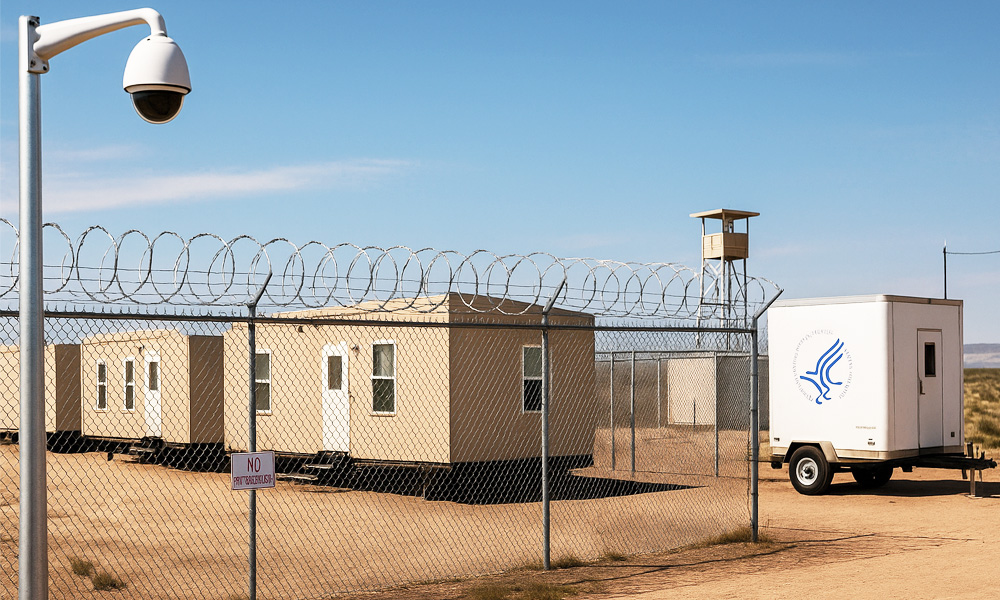News
The DOGE HHS Migrant Housing Contract That Cost $18M a Month
Published
5 months agoon
By
Admin
In early 2025, a surprising story started making headlines — a single migrant housing contract was costing the U.S. government a jaw-dropping $18 million every month. That’s right. One shelter, millions of dollars, and barely any people inside.
The deal was between the Department of Health and Human Services (HHS) and a nonprofit group called Family Endeavors. But then came DOGE — the Department of Government Efficiency — and everything changed.
In this article, we’ll walk you through exactly what the DOGE HHS Migrant Housing Contract was, how it worked, why it became such a big deal, and what this means for taxpayers, migrant children, and the future of government spending. Let’s break it down in simple words.
What Is the DOGE HHS Migrant Housing Contract?
To understand the whole story, let’s first look at the two main players:
-
DOGE stands for Department of Government Efficiency. It was created by Donald Trump in 2025 with one big goal — to cut waste and save money in the government.
-
HHS stands for Health and Human Services, and they handle a lot of important jobs, like child care, health programs, and refugee support.
Now, the DOGE HHS Migrant Housing Contract was a deal where HHS paid Family Endeavors, a nonprofit from San Antonio, Texas, to run a large shelter for unaccompanied migrant children — kids who crossed the border alone and needed care.
The shelter was located in Pecos, Texas, and the idea was to have it ready at all times, just in case there was a surge in kids needing a safe place. Sounds good in theory, right? But as we’ll see, the situation got more complicated.
Where Did the $18 Million Go?
The contract between HHS and Family Endeavors was worth $18 million every month. That adds up to over $215 million a year. So, where was all this money going?
According to the government records, the money covered a lot of things:
-
The lease of the Pecos facility.
-
Salaries for staff, security teams, and medical workers.
-
Food services, legal services, and mental health programs.
-
Special equipment like vaccine refrigeration and hundreds of cameras for safety.
Even when no children were living there, these things still needed to be paid for, just in case the shelter had to reopen quickly. The nonprofit said the place had to stay fully prepared 24/7, just like a fire station.
But in 2024 and early 2025, reports showed that the Pecos shelter was mostly empty, while the government was still paying full price. That’s when people started asking serious questions.
The Story of the Pecos Shelter
The Pecos facility was a huge, ready-to-go shelter made to care for up to 2,000 migrant children at a time. It had everything: medical rooms, classrooms, beds, and even areas for legal help.
Family Endeavors operated the shelter through a sole-source contract, meaning they got the job without a bidding process. That’s not illegal, especially in emergencies, but it did raise eyebrows.
Here’s the timeline:
-
March 2021 to March 2023: The shelter was in use and cared for thousands of children.
-
September 2023 to February 2024: It reopened and again served many kids.
-
March 2024 to early 2025: The shelter was closed but still funded, just in case it needed to reopen.
According to Endeavors, during the period it was active, the shelter served over 40,000 minors. That’s a big number. But during the downtime, it sat mostly empty while still costing millions every month.
Why DOGE Stepped In
In early 2025, DOGE started looking at contracts across the government. Their goal? Cut spending on things that didn’t seem useful anymore.
When they found the DOGE HHS Migrant Housing Contract, they saw something that didn’t make sense. The Pecos shelter was empty, but the government was still paying $18 million per month.
DOGE launched an audit. They looked at all the documents, invoices, and numbers. Their team found that the shelter was often less than 20% full, and sometimes had no children at all.
That’s when DOGE made their move. They posted on X (formerly Twitter) that the contract was being canceled, and said this would save taxpayers over $215 million per year.
DOGE said it was a clear case of waste, and they were proud to stop it. But that’s not where the story ends.
What Happened After the Audit
After DOGE announced the termination of the contract, the news spread fast. Supporters of DOGE praised the move, saying it showed how serious they were about cutting government waste.
But not everyone agreed.
Family Endeavors pushed back, saying the shelter wasn’t a waste at all. They said it was ready to open at a moment’s notice, and that keeping it open cost money whether kids were there or not. After all, you can’t suddenly open a shelter without staff, food, or working security cameras.
They also said that federal officials were visiting daily, and that it wasn’t their decision to keep the shelter open or closed — it was the government’s. Still, the contract ended, and the funding stopped.
Was There a Conflict of Interest?
After the contract was canceled, DOGE shared more details on why they believed something wasn’t right. They pointed out that a former ICE official, who had also worked on the Biden transition team, had joined Family Endeavors shortly before the contract was awarded.
That raised questions. Was this person involved in helping secure the deal? Was it fair to other nonprofits that never got a chance to apply? DOGE suggested that connections — not just qualifications — might have helped the nonprofit win the contract without competition.
To make it even more interesting, Family Endeavors’ total assets reportedly jumped from $8.3 million in 2020 to $520.4 million in 2023. That’s a huge increase in just a few years. While the nonprofit said it was because they had taken on more government work, critics felt it looked suspicious.
Still, there was no official proof of wrongdoing. Family Endeavors said clearly that the deal was legal, approved by federal agencies, and based on their years of experience helping migrant families.
What About the Migrant Kids?
While the focus of this story was mostly about money, real children were at the heart of it.
The Pecos facility was meant to help unaccompanied minors — kids crossing the border alone, often scared and without any family nearby. These kids need a lot of care: shelter, food, medical help, and someone to guide them through legal steps.
When DOGE shut down the contract, some people celebrated the savings. But others, including migrant advocates, worried that cutting facilities too fast could leave children without safe places to go during border surges.
One advocate said it best: “These kids are not line items in a budget. They are people who need help.” That’s something worth thinking about. How do we balance saving money with taking care of people?
Elon Musk’s Role in the Story

Let’s not forget one of the most talked-about names in this story: Elon Musk.
Musk was one of the main forces behind DOGE. He was brought in by Donald Trump to help run the department like a business — fast, lean, and focused on numbers.
After the Pecos contract was canceled, Musk posted about it on X, saying this was proof that DOGE could make real changes. He called it a win for taxpayers and a step toward a more efficient government.
But Musk’s involvement also raised eyebrows. Some asked: if Musk is helping decide which contracts to cancel, what about the $18 billion in government contracts that his own companies (like SpaceX and Tesla) have received since 2015? Would those ever be reviewed the same way?
This part of the story made things even more complex.
Fallout Across the Government
The Pecos contract was just the beginning. Once DOGE showed it could cancel one big deal, it started reviewing others, too.
By April 2025, DOGE had reportedly cut more than 280,000 federal jobs across various departments, including the Department of Defense (DOD). Some of these roles had been around for decades. Suddenly, they were gone.
People who worked in those jobs were left shocked. Some had given 20 years or more to public service. Now, they were unemployed, and many didn’t feel appreciated.
DOGE said it was necessary to clean up the system. Critics said it was rushed and lacked heart.
What People Are Saying
This entire story sparked strong opinions.
DOGE supporters believe this is how the government should work — clean up the waste, protect taxpayers, and hold people accountable.
Critics, on the other hand, feel that important services are being cut too quickly. They worry that children, workers, and even national security are being overlooked just to hit cost-saving goals.
Here’s a mix of what people have said:
-
“Finally, someone is cleaning up the mess in Washington.”
-
“Cutting this contract hurt kids more than it helped.”
-
“I gave everything to my job, and now I’m out — like I never mattered.”
It’s clear this isn’t just a budget issue. It’s personal for many.
What Happens Next?
So, where do we go from here?
Even though Elon Musk has left DOGE, the department is still active. The Trump administration has said it plans to expand DOGE’s role, possibly putting someone like Russell Vought in charge.
Meanwhile, government agencies are under pressure to prove they’re using every dollar wisely. Contracts like the DOGE HHS Migrant Housing Contract will face closer review from now on.
But there are still big questions:
-
What happens during the next surge of migrant children?
-
Can the government reopen safe shelters in time?
-
And how do we make sure we’re saving money without hurting people?
These are the hard questions — and there are no easy answers.
Bottom-Line
The DOGE HHS Migrant Housing Contract tells us a lot about how the U.S. government is changing in 2025. It’s a story about big money, power, and tough choices.
On the one hand, cutting waste is important. Taxpayers should know where their money goes. But on the other hand, we must remember the human side — kids in need, families at the border, and workers who gave years to their jobs.
Maybe the answer is somewhere in the middle: smarter spending, better planning, and more compassion.
One thing is clear: stories like this matter. They remind us to stay alert, ask questions, and always put people first — even when talking about billions of dollars.
(FAQs)
How much did the government pay for an empty shelter?
The HHS was paying $18 million every month to run a migrant shelter in Pecos, Texas — even when it had few or no children inside.
Why did DOGE cancel the migrant housing contract?
DOGE claimed the contract was a massive waste of taxpayer money, saying it would save $215 million per year by ending it.
Did the nonprofit behind the shelter get rich?
Yes — Family Endeavors’ assets reportedly grew from $8.3 million in 2020 to over $520 million by 2023 after landing government contracts.
Was this shelter ever full?
Not recently. In 2024–2025, the facility was often less than 20% full — and sometimes completely empty — while still fully funded.
Did Elon Musk have anything to do with this?
Yes — Elon Musk helped lead DOGE when the contract was canceled, sparking debate about his role in cutting deals while his own companies had $18B in federal contracts.
You Might Also Like: Delta Flight DL275 Diverted LAX

Data Privacy and Confidentiality in Legal AI: Keeping Sensitive Matters Secure

Jodi Faeth: What Happened to Mike Wolfe’s Ex-Wife After Divorce?

How GEO Helps Startups Compete With Enterprise-Level AI Visibility

Who Is Cassandra Marino? Caitlyn Jenner’s Daughter Who Lives a Private Life

Get to Know Nathan Andersen: A. J. Cook’s Husband and Proud Family Man

From Digital to Tangible: The Human Impact of Cryptocurrency to Fiat Adoption

The Real Story of Melissa Meeks, Jeremy Meeks’ Famous Ex-Wife

MegaCustom: Personal Gifts Made Beautiful

Design Something Special with MegaCustom

Top 10 SEO Agencies for Barber Shops

Who Is Marlene Knaus? The Untold Story of Niki Lauda’s First Wife

Curious About JOI Database? Read This First Before You Click Anything

Jacqueline Bernice Mitchell: The Inspiring Story of Jerry Rice’s Ex-Wife

Should You Use Wooflix in 2025? Honest Review and Best Alternatives

Where Is Noelle Watters Now? Jesse Watters’ Ex-Wife’s Life After Divorce

Where Is Barbara Boothe Now? Inside Her Life After Larry Ellison

Alisande Ullman Today: What Happened After Her Divorce from Leslie Nielsen?

Where Is Tanya Hijazi Now?: All About Rick James’ Former Wife

Wendy Lang: Meet the Therapist Married to Cenk Uygur

Mickey Middleton: The Untold Story of Bryan Cranston’s First Wife

Data Privacy and Confidentiality in Legal AI: Keeping Sensitive Matters Secure

Jodi Faeth: What Happened to Mike Wolfe’s Ex-Wife After Divorce?

How GEO Helps Startups Compete With Enterprise-Level AI Visibility

Who Is Cassandra Marino? Caitlyn Jenner’s Daughter Who Lives a Private Life

Get to Know Nathan Andersen: A. J. Cook’s Husband and Proud Family Man

From Digital to Tangible: The Human Impact of Cryptocurrency to Fiat Adoption

The Real Story of Melissa Meeks, Jeremy Meeks’ Famous Ex-Wife

MegaCustom: Personal Gifts Made Beautiful

Design Something Special with MegaCustom

Top 10 SEO Agencies for Barber Shops
Categories
Trending
-

 Celebrity6 months ago
Celebrity6 months agoWho Is Marlene Knaus? The Untold Story of Niki Lauda’s First Wife
-

 Entertainment5 months ago
Entertainment5 months agoCurious About JOI Database? Read This First Before You Click Anything
-

 Celebrity3 months ago
Celebrity3 months agoJacqueline Bernice Mitchell: The Inspiring Story of Jerry Rice’s Ex-Wife
-

 Entertainment5 months ago
Entertainment5 months agoShould You Use Wooflix in 2025? Honest Review and Best Alternatives
